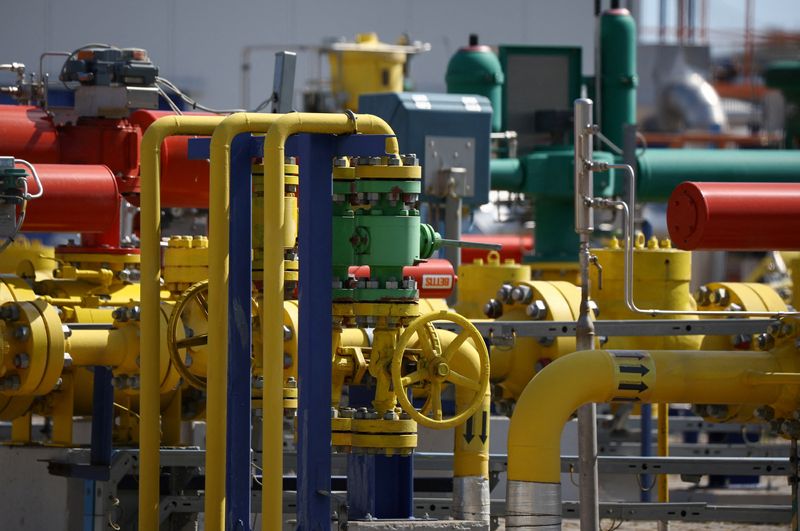By Kate Abnett and Bozorgmehr Sharafedin
BRUSSELS/LONDON (Reuters) - European countries are buying gas at sky-high prices and scrambling to curb energy use to avoid fuel shortages this winter, but early weather forecasts point to the risk of a cold snap that could temporarily hike demand.
Surging European gas and power prices as the result of reduced Russian supplies are stoking inflation, hampering industrial activity and inflicting record-high bills on consumers ahead of the northern hemisphere winter.
Despite high gas storage levels and steady flow of liquefied natural gas (LNG), the continent still faces risks of power shortages, blackouts and energy rationing which could worsen the economic pain.
Early winter forecasts released by the European Centre for Medium-Range Weather Forecasts (ECMWF) on Thursday said Europe could face a cold snap in December - indicating a potential extra energy squeeze, as countries attempt to cope with scarce Russian gas supplies and sky-high energy prices.
"There is still a very significant risk of having a cold outbreak. And if anything, the risk is slightly higher than usual," Carlo Buontempo, Director of the Copernicus Climate Change Service at ECMWF, told Reuters.
For the next few weeks, the weather in Western Europe is looking mild, thanks to warm westerly winds from the North Atlantic. But ECMWF's models show a higher than usual chance of a high pressure system developing over Europe in December, bringing cold air from Siberia and Central Asia and causing a drop in temperature of potentially several degrees.
"If we have a drop in temperature, we could expect an uptick in energy demand for heating," Buontempo said.
Medium term forecasts can't predict with certainty that an event will occur, or its duration - "blocking patterns" of high pressure can last just a week, or longer. But the forecast offers an early indication to companies and governments attempting to assess how much gas will be needed to heat homes.
A cold snap could increase that demand. A cold spell in late September saw gas consumption among German households and small industry jump to 14.5% above the average for the same week in the past four years.
"The demand from households will be a huge question mark," said Cuneyt Kazokoglu, director of energy economics at consultancy FGE.
MILD OR COLD
A cold spell-induced uptick in gas demand could collide with reduced renewable power generation, as high pressure systems tend to mean less wind and rain - although a trend for such systems to have less cloud cover could boost solar output.
Gas storage buffers should help, but not for all weather scenarios. EU countries have filled their gas tanks to an average of about 92% of capacity, by snapping up non-Russian gas at record prices in recent months to build a supply buffer, as Moscow progressively cut deliveries after Western sanctions in response to the Ukraine war that began in February.
But some analysts warn this alone will not compensate for the loss of Europe's main gas supplier - and a cold winter would make this worse. Russian gas now comprises less than 8% of Europe's supply, down from around 40% before Moscow invaded Ukraine - and Brussels has warned a full shut-off is possible.
"Europe is currently risking a shortfall of around 7-8% of demand over the winter, around 20 billion cubic metres (bcm). A harsh winter could effectively double that," said Emmanuel Dubois-Pelerin, a managing director at S&P Global (NYSE:SPGI) Ratings.
"If the temperatures are mild, then Europe will not have to ration, nor have to accelerate (gas) demand reduction," he added.
NEXT WINTER
But it's not only Europe's weather that matters. As Russian supply cuts have deepened, Europe has relied on LNG to help fill the gap - snapping up cargoes in global markets where they compete with Asian buyers.
A cold winter in Europe could add 8 bcm to Europe's gas demand, said Energy Aspects analyst Leon Izbicki.
If Asia also faced a cold winter, and needed more gas for its own heating, Europe could face a gas supply gap of 19 bcm - and end winter with its storage just 18% full, a level Izbicki said could cause regional fuel shortages.
"Storage should never get that low," he said. "Demand for LNG in Asia is going to be critical as a determining factor for how much energy Europe can actually get over the course of this winter."
If cold weather depletes gas storage levels this winter, Europe will need to replenish for next winter - with far less Russian gas.
Russian gas supplies to Europe have dropped to around 85 mcm per day from 360 mcm per day in September 2021, according to Bernstein analysts, as Moscow progressively curbed flows through the Nord Stream network to Germany and through other routes.
Unexplained damage last month to the Nord Stream pipelines that run under the Baltic Sea appear to have dashed any hopes that gas flows would resume.
Marina Tsygankova, commodities research manager at Refinitiv, said Europe will only manage to refill storage in time for next winter, if this one is mild or if gas demand drops.
"You need to either pray for mild winter or more demand destruction needs to happen," she told a conference in London last week.

EU countries have agreed a 15% voluntary gas demand cut for winter - which Brussels has said would ensure enough fuel for an average winter, but not a cold one.
A document published by the European Commission last month showed EU countries' gas demand was 13% lower in May than the five-year average for the month, 7.6% lower in June and 10.7% lower in July.